Get all the latest news on coronavirus and more delivered daily to your inbox. Sign up here.
An area of disturbed weather developed off Florida into the first named storm of the 2020 Atlantic hurricane season weeks before it officially started — continuing a trend of preseason activity for a sixth year.
The U.S. National Hurricane Center (NHC) said Tropical Storm Arthur has maximum sustained winds of 45 mph as of 11 a.m. Sunday, and is located about 345 miles south-southwest of Cape Hatteras, N.C. The storm is moving north-northeast at 9 mph.
"On the forecast track, Arthur will remain well offshore the east coast of Florida, Georgia, and South Carolina today, and then move near or just east of the coast of North Carolina on Monday," the NHC said.
TROPICAL STORM ARTHUR FORMS OFF FLORIDA, WARNING ISSUED FOR NORTH CAROLINA'S OUTER BANKS
The tropical storm is forecast to turn toward the northeast with an increase in forward speed over the next 24 to 48 hours. Tropical storm warnings have been posted from Surf City to Duck, N.C., including the Pamlico and Albermarle Sounds.
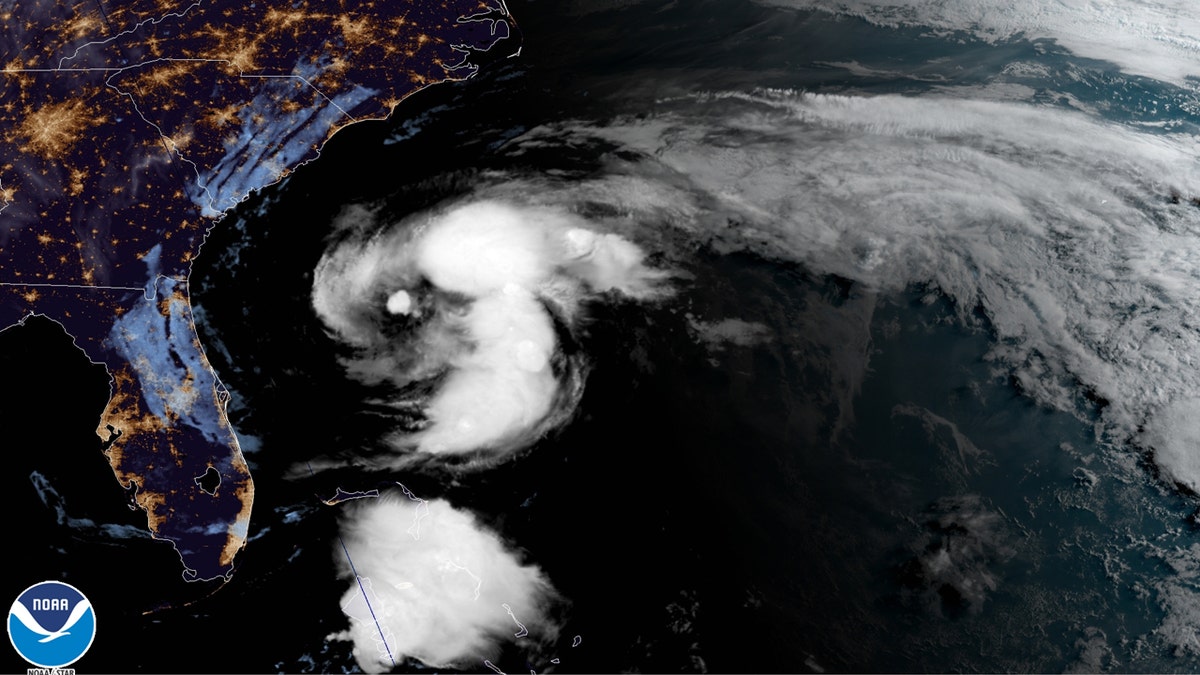
Tropical Storm Arthur can be seen swirling off the Southeast coast on Sunday, May 17, 2020. (NOAA/GOES East)
Forecasters from the NHC said some strengthening is in the forecast during the next 48 hours, but Arthur is likely to lose its tropical characteristics on Tuesday. Tropical-storm force winds extend outward up to 80 miles from the center of the storm.
Tropical storm conditions are expected by Monday, with total rain accumulations between 1 and 3 inches over coastal North Carolina from Sunday night into Monday, with locally higher amounts.
HURRICANE FORECASTS WILL SEE SOME CHANGES FOR 2020: HERE'S WHAT WILL BE DIFFERENT
While the Atlantic Basin season officially runs from June 1 to Nov. 30, plenty of May storms have developed in recent years. In fact, the first named storm of the season has been in May every year since 2015.
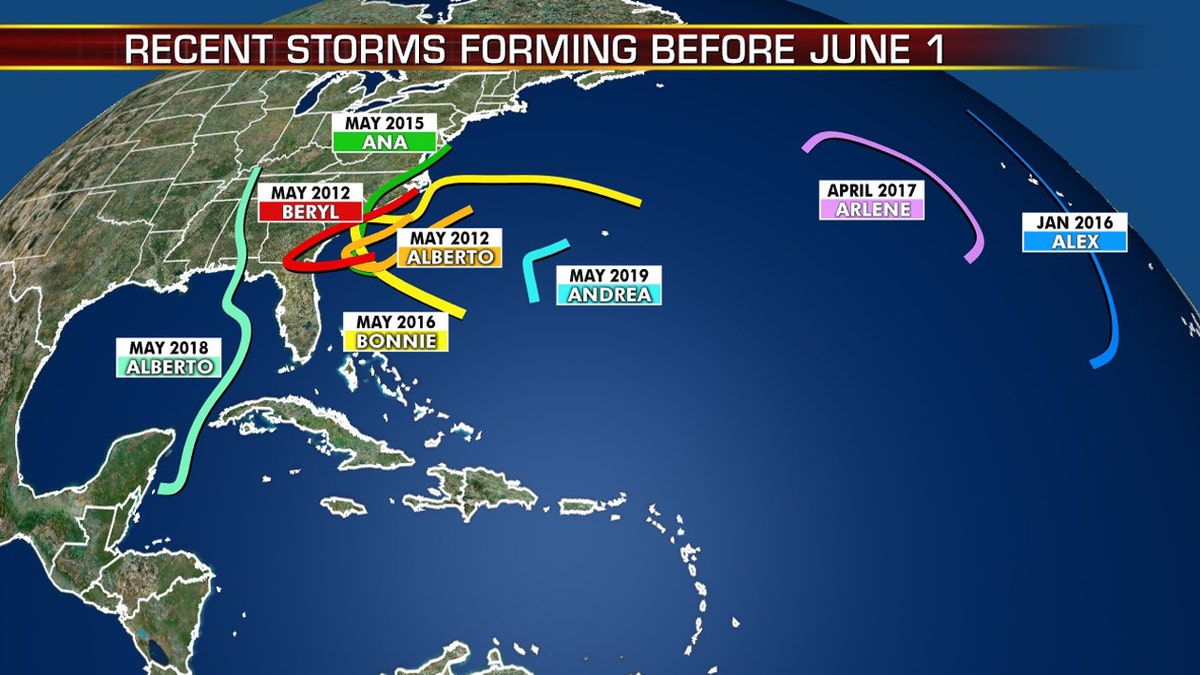
A look back at previous storms that have formed before June 1, the official start of Atlantic hurricane season. (Fox News)
Here are some of the recent storms that have formed before June 1:
Subtropical storm Andrea, May 2019: The 2019 Atlantic Hurricane season got off to an early start when the first named storm formed and quickly fizzled a day later over the Atlantic, southwest of Bermuda.
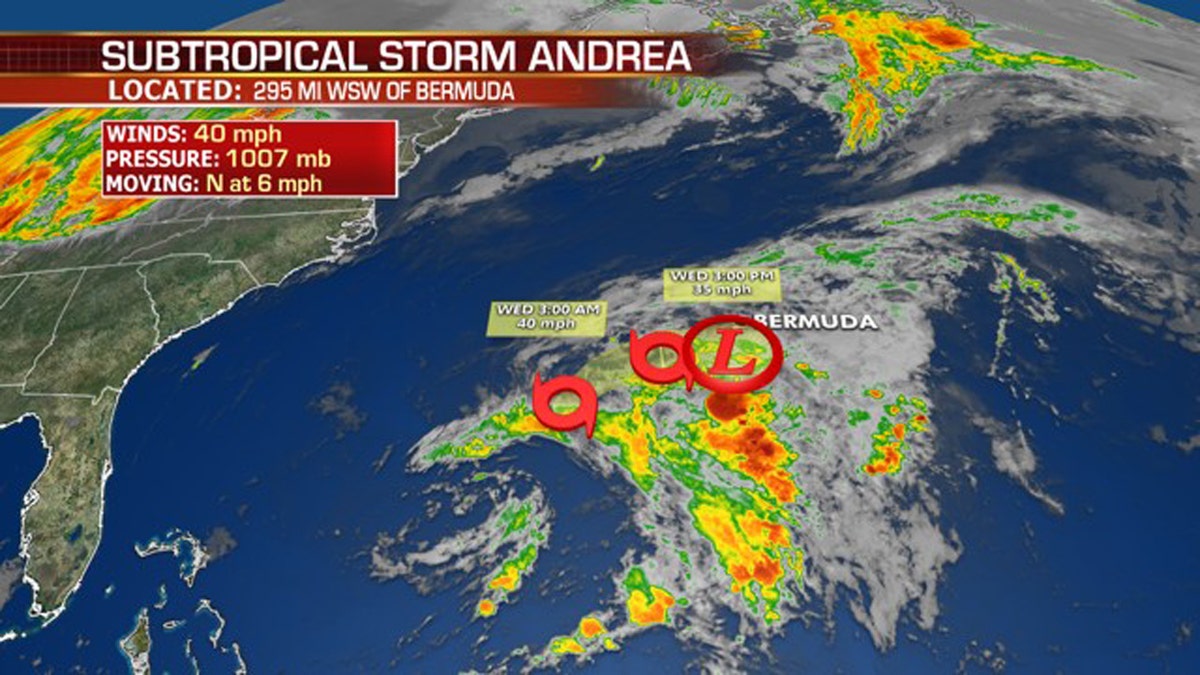
Subtropical storm Andrea formed southwest of Bermuda in May 2019, only to weaken a day later. (Fox News)
The NHC said Subtropical storm Andrea quickly weakened to a subtropical depression. A subtropical storm has a less defined and cooler center than a tropical storm and its strongest winds aren’t in its center.
Subtropical storm Alberto, May 2018: The Memorial Day weekend along the Gulf Coast became a washout after Subtropical Storm Alberto made landfall during the holiday weekend.
The storm came ashore near Laguna Beach in the Florida panhandle, bringing a storm surge, the threat of tornadoes to the Southeast and heavy rain, with up to a foot of rain across the Florida panhandle into Alabama.
WHAT WAS THE WORST HURRICANE TO HIT THE US? HERE ARE THE DEADLIEST STORMS EVER
Tropical Storm Arlene, April 2017: Tropical Storm Arlene was only the second tropical storm on record to form in the month of April, according to the NHC.
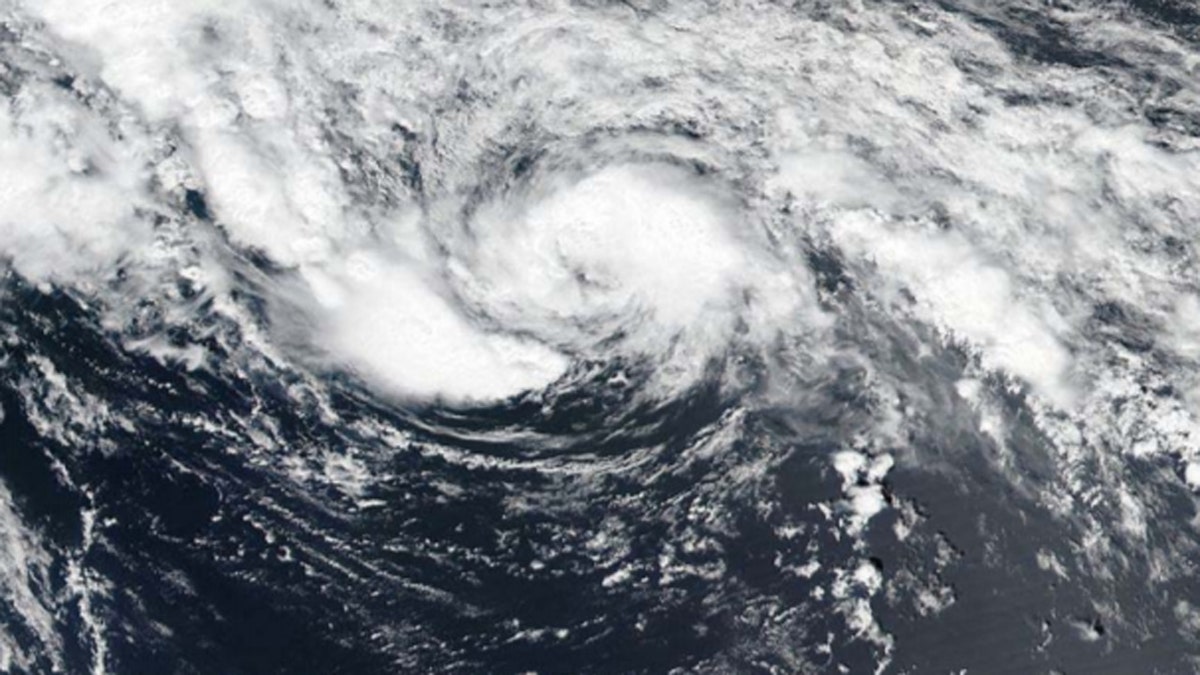
A satellite image of Tropical Storm Arlene on April 20, 2017. (NOAA/NWS)
The storm reached tropical storm strength on April 20, 2017, about 700 miles west of the Azores before it weakened two days later.
"Arlene was short lived and meandered over the central Atlantic Ocean," the NHC said in a report on the storm.
Hurricane Alex, January 2016: Alex has the distinction of being dubbed by the NHC as a "very unusual hurricane" that formed in the northeastern Atlantic Ocean.
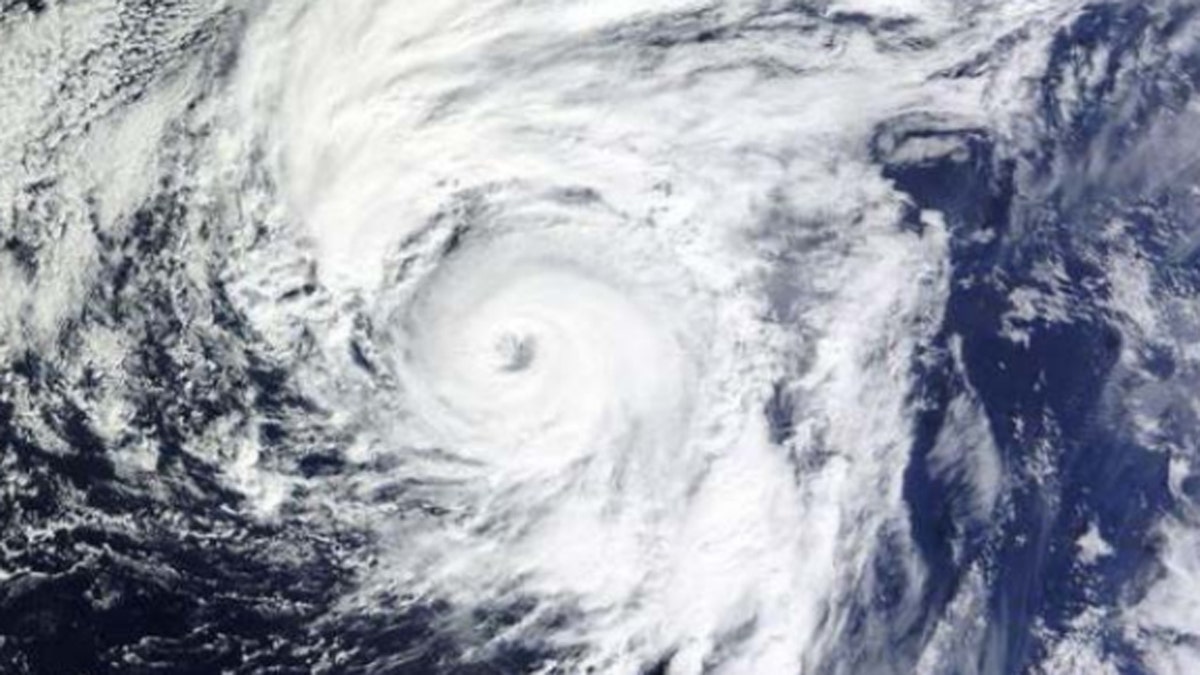
Hurricane Alex can be seen swirling in January 2016. (NASA/MODIS/NHC)
The storm became a hurricane on Jan 14, 2016, weakening and making landfall on the island of Terceira in the Azores as a tropical storm.
Tropical Storm Bonnie, May 2016: Tropical Storm Bonnie formed northeast of the Bahamas on May 28, 2016. The NHC said the storm made landfall near Charleston, S.C., as a tropical depression and brought heavy rainfall to coastal sections of the Carolinas.
CLICK HERE FOR MORE WEATHER COVERAGE FROM FOX NEWS
Tropical Storm Ana, May 2015: Tropical Storm Ana reached tropical storm strength on May 9, 2015, according to an NHC report.

Tropical Storm Ana can be seen in this May 2015 satellite photo. (NOAA GOES-15/NWS)
The storm later made landfall along the northeastern coast of South Carolina, causing minor wind damage, some beach erosion, and one direct death in North Carolina.
Tropical Storm Alberto, May 2012: The tropical storm formed on May 18, 2012, off the coast of Charleston, S.C, and weakened a few days after before dissipating a couple hundred miles north of Bermuda.
Tropical Storm Beryl, May 2012: Beryl was a pre-season tropical storm that made landfall on May 28, 2012, in northeastern Florida and also impacted portions of the southeastern United States.
An NHC report on the storm says Beryl was the strongest pre-season tropical cyclone of record to make landfall in the United States.
What does that pre-season activity mean for the 2020 Atlantic hurricane season?
According to Fox News meteorologist Adam Klotz, while it is early to see tropical activity, it’s not a "huge surprise" since May has been an active tropical month in recent years.
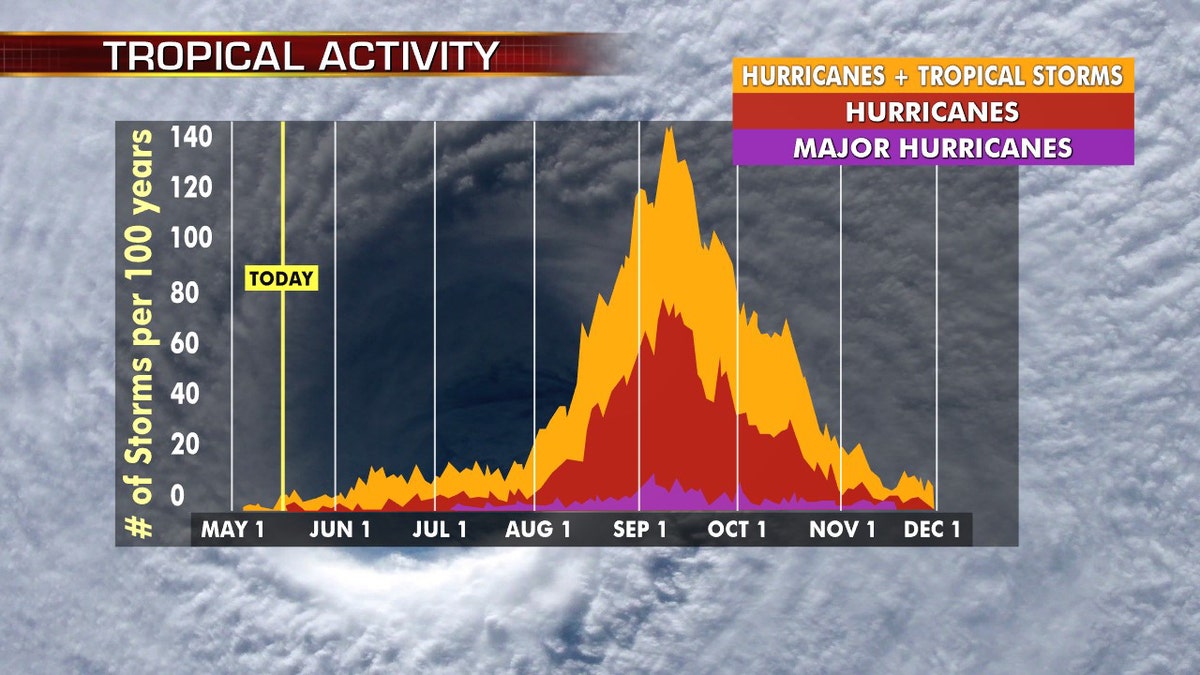
A look at historical tropical activity. (Fox News)
Since 2003, there actually have been pre-June 1 named storms six out of 17 seasons, with all signs pointing to more activity than average this season. That's due primarily to the absence of El Niño, with less hostile wind shear, along with warmer than average sea-surface temperatures.

The 2020 Atlantic hurricane season may include above-average activity. Here are what researchers at Colorado State University are forecasting, compared to average. (Fox News)
"A strong El Niño limits tropical storms because strong winds in the upper atmosphere rip the tops of developing storms off," Klotz said Wednesday. "This year, we won’t have that."
On average, 12 tropical storms – six of which become hurricanes – form over the Atlantic Ocean, Caribbean Sea or the Gulf of Mexico during hurricane season, according to the National Weather Service (NWS).

What to know about the approaching Atlantic hurricane season. (Fox News)
On average, there is a tropical storm every two years in June, according to Fox News senior meteorologist Janice Dean.
While the National Oceanic and Atmospheric Administration Climate Prediction Center will provide its seasonal outlook for the Atlantic basin on May 21, researchers at Colorado State University are predicting an above-average hurricane season this year, citing the likely absence of El Niño as a primary factor.
Researchers at Colorado State are predicting 16 named storms, of which eight are forecast to become hurricanes. Four are expected to reach major hurricane strength with winds greater than 111 mph.

The names for the 2020 Atlantic hurricane season. (Fox News)
Klotz said that Arthur should be a wakeup for coastal residents that it only takes one big landfall to make it feel like a "really bad year."
"It does serve as a reminder that we are heading into what could be an active year," Klotz said. "It’s never too early to start preparing."
CLICK HERE FOR THE FOX NEWS APP
The 2020 Atlantic hurricane season will include the names: Arthur, Bertha, Cristobal, Dolly, Edouard, Fay, Gonzalo, Hanna, Isaias, Josephine, Kyle, Laura, Marco, Nana, Omar, Paulette, Rene, Sally, Teddy, Vicky and Wilfred.
Fox News' Janice Dean and Adam Klotz contributed to this report.



